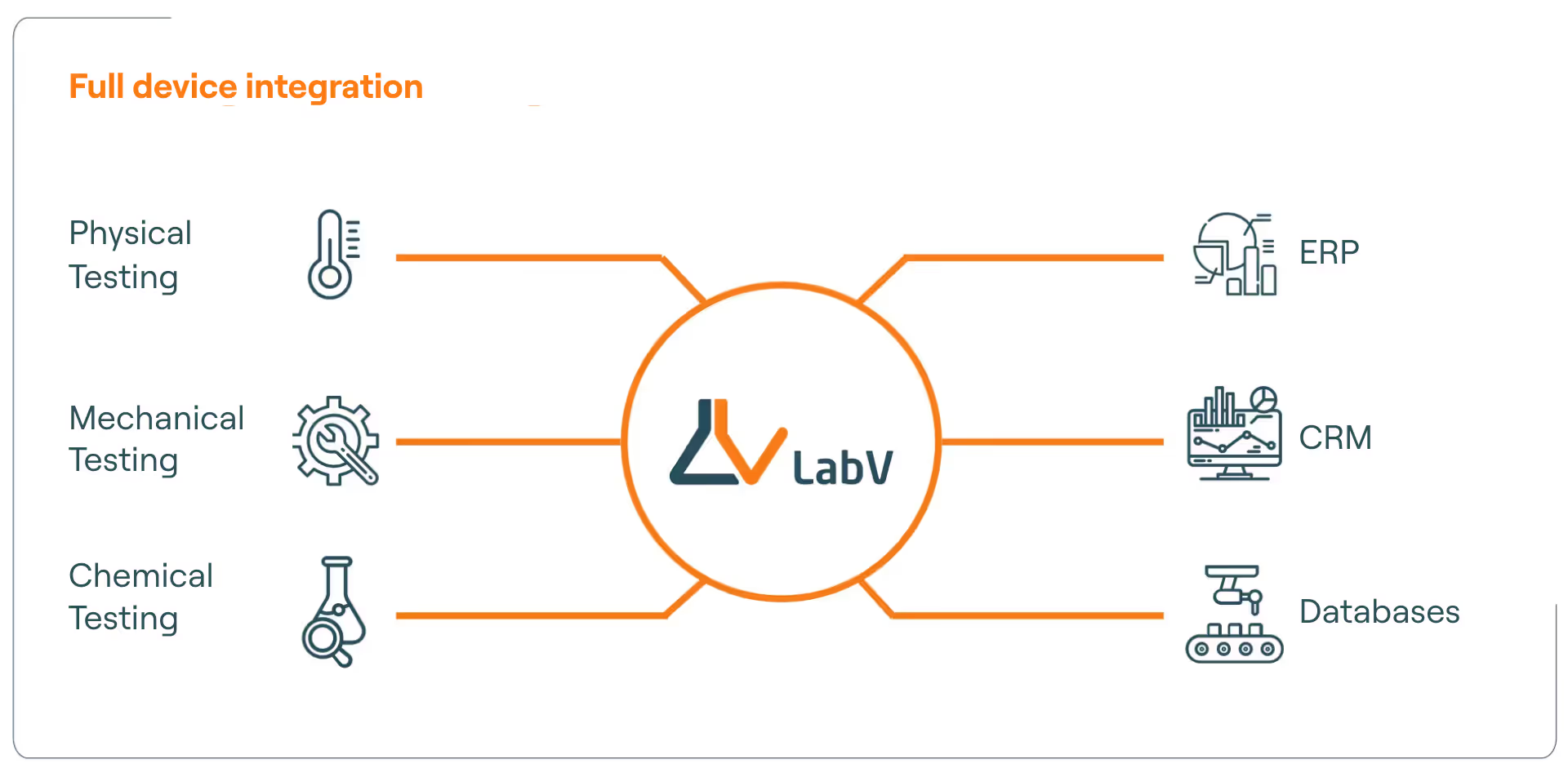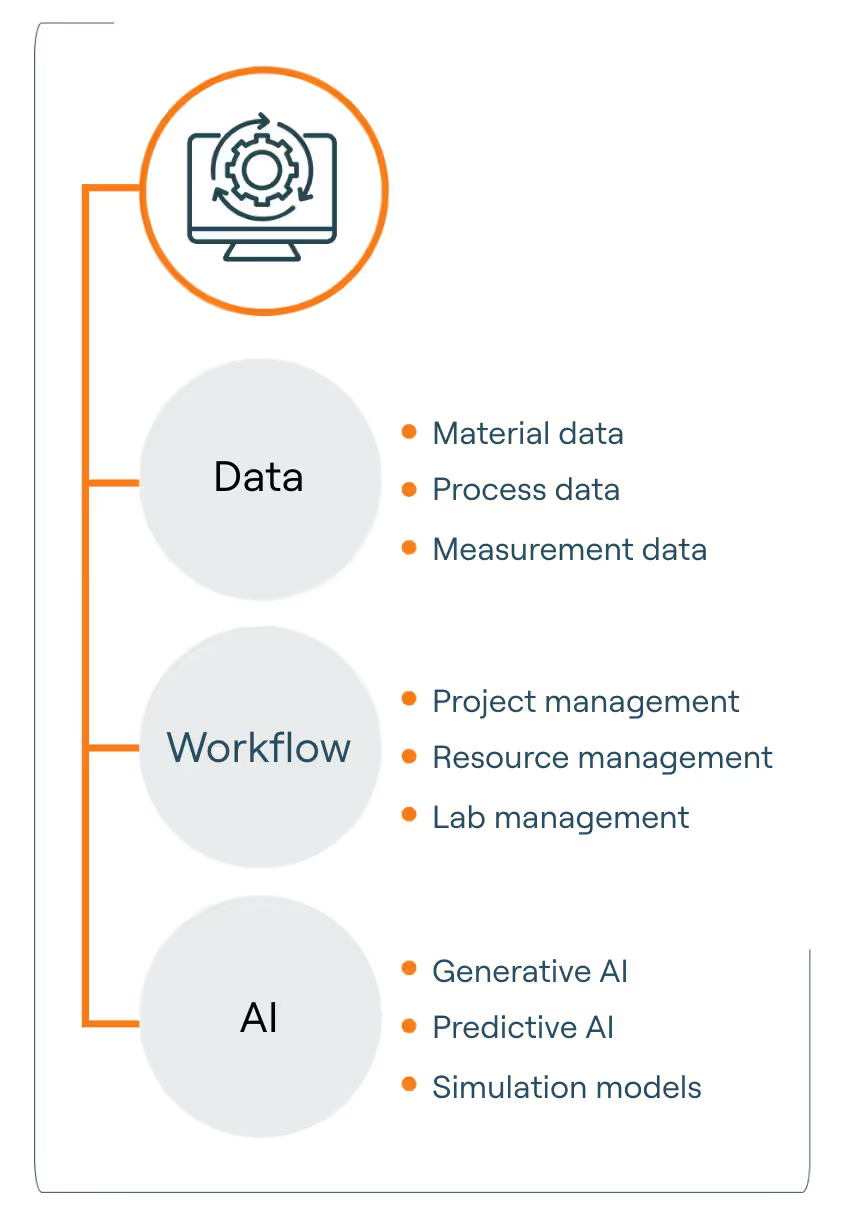Which Laboratory Software Is Right for R&D?
Wer heute in einem F&E-Labor arbeitet, kennt die Situation: Es gibt unzählige Softwarelösungen und doch fühlt sich vieles nach „Standard“ an. Ein LIMS, ein ELN, dazu noch ein paar Excel-Tabellen: Damit lässt sich der Alltag irgendwie organisieren. Spätestens wenn Daten gleichzeitig an mehreren Stellen entstehen oder historische Ergebnisse in aktuelle Projekte einfließen sollen, zeigt sich das Problem: Wissen ist verteilt, Daten sind schwer vergleichbar, Verwaltung bindet Ressourcen – und ohne Integration entstehen Inseln statt Fortschritt.
Die entscheidende Frage lautet also: Welche Software passt wirklich zur F&E und nicht nur zur Dokumentation oder Qualitätskontrolle?
Die Antwort führt weg von klassischen Standardlösungen und hin zu Plattformen, die Daten zusammenführen, Analysen ermöglichen und Wissen langfristig verfügbar machen. Material Intelligence Plattformen wie LabV gehen dabei einen Schritt weiter: Sie unterstützen nicht nur, sondern treiben Forschung und Entwicklung mit KI-Unterstützung voran.
Anyone working in an R&D lab today knows the situation: there’s no shortage of software tools, yet most of them feel like the same old standard setup. A LIMS, an ELN, plus a few Excel sheets on the side are enough to get through the day, more or less. But as soon as data is generated in multiple places at once, or when past results are supposed to be incorporated into ongoing projects, the system begins to crack. Knowledge is scattered, data is hard to compare, and administration eats up valuable time. Without proper integration, you don’t build progress. You build silos.
So the real question is: Which software truly supports R&D and is not just documenting?
The answer lies beyond traditional standard tools. What’s needed are platforms that bring data together, enable analysis, and make knowledge usable in the long term. Material Intelligence Platforms like LabV take this even further: they don’t just support research and development, they actively accelerate it with an AI-driven digital assistant.
Traditional Software: What They Can Do and Where They Fall Short
LIMS: Powerful in Quality Control, Too Rigid for Development
A Laboratory Information Management System (LIMS) is indispensable when it comes to sample tracking, traceability, and regulatory compliance. In quality control labs, and in particular in pharmaceuticals or food safety, a LIMS is the unquestioned standard.
But the reality in R&D looks very different. Development work rarely follows fixed testing protocols. It is iterative by nature: formulations are adjusted, results are compared, and data is continuously reinterpreted. This is precisely where a LIMS reaches its limits. Its core logic is built for predefined workflows, but not for flexible, experimental processes.
For an R&D team, this often means:
• Every new formulation development project has to be forced into rigid structures before it can even be documented.
• Adjustments during the project are difficult and usually require detours or workarounds.
• Knowledge remains locked within individual projects instead of being reused or leveraged across teams.
That’s why LIMS may be indispensable in quality assurance but can quickly become a bottleneck in development environments.
A coatings manufacturer in southern Germany encountered exactly this issue. The team attempted to document formulation trials within their existing LIMS only to discover that the software was built around test protocols and standardized procedures. It offered no room for rapid iteration or spontaneous experimentation. Every new trial required awkward workarounds. Eventually, the developers returned to Excel and recreated the very data chaos the system was meant to avoid.
ELN: Digital Lab Notebooks Without Process Logic
An Electronic Lab Notebook (ELN) is lab software that simplifies documentation and improves traceability. This is helpful for research teams when recording observations, notes or measurement results. However, ELN systems remain islands: they document without linking projects, data flows or teams.
Excel: Flexible, but Risky
Excel is the “Swiss Army knife” of the laboratory. But is it truly suitable as R&D software? Spreadsheets are flexible, familiar, and instantly available. For simple tables or formulations, they’re convenient. But as data volumes grow, Excel becomes error-prone and multiple files quickly turn into a maze. In the end, this becomes a real barrier to innovation.
An example from the paint and coatings industry illustrates this clearly. A mid-sized manufacturer had been managing formulations in Excel for years. When a new project manager tried to review earlier test series, he found duplicated files, conflicting data and no version history. Consolidating everything took weeks. What had once been a flexible solution had turned into a problem.
👉 Interim conclusion: LIMS, ELN and Excel are laboratory tools that collect data, but they don’t help derive knowledge from it or speed up development cycles.
Why Research and Development Needs More
Research and development is dynamic: data is generated in multiple places at the same time, experiments are iterative, and questions evolve constantly. Traditional laboratory systems, however, are built for static processes and not for the realities of research. They simply aren’t R&D software.
The result:
• They manage data, but they don’t support decision-making
• They document, but they don’t accelerate development
• They provide security and traceability, but they don’t drive innovation
To stay competitive today, R&D teams need software that supports its work :
• Data must be connected and not isolated
• Knowledge must become reusable
• Decisions need real-time support and not just historical insight
Modern Alternativs for the R&D
Modern LIMS
Modern LIMS are essentially evolved versions of traditional systems. They offer more structured data models, user-friendly interfaces, integration capabilities, and often cloud-based deployment. Unlike older solutions, they don’t just record data, but also provide basic analytics and vizualisations. This makes onboarding easier, improves usability, and reduces maintenance efforts.
However, despite these improvements, the underlying logic remains unchanged. A modern LIMS is still fundamentally designed for clearly defined workflows in quality control. In R&D, where experiments evolve iteratively and data needs to be flexibly linked and interpreted in new contexts, this structure quickly becomes restrictive.
R&D Platforms
R&D platforms go beyond traditional laboratory software. Instead of being tied to predefined workflows like a LIMS, they map the entire development process covering projects, data and the people involved. This creates a continuous flow of information. Results are no longer isolated; they become comparable, reusable and applicable in new contexts.
Unlike LIMS, these platforms are true R&D software: not just for documentation and administration, but as tools for active knowledge management. Data can be analyzed, linked and related to one another. Existing know-how from earlier formulations or optimization cycles is incorporated and used for new development iterations.
Technologically, most solutions rely on cloud-based infrastructures, modern usability standards and data-driven logic. Their goal is to systematically preserve development knowledge and make it usable across teams.
Material Intelligence Platforms
Material Intelligence Platforms such as LabV go one step further. They connect formulations, testing and processes within a single system, creating a unified data environment.

Their strengths are clear:
• Consistent data foundation: Raw materials, formulations, results and approvals are logically linked.
• Decision support: AI-driven analyses provide recommendations, help identify trends and reveal correlations that would otherwise remain hidden
• Efficiency: Existing knowledge can be reused, development cycles become shorter and traceability improves
• Real-time comparison: Experiments can be viewed side by side instantly, saving enormous time in R&D.
• Standardized workflows with flexibility: Repetitive steps can be automated without restricting the creative freedom required in research.
The result is a system that not only documents but makes the entire R&D cycle more productive. It creates a knowledge base that extends beyond individual projects and facilitates collaboration between departments such as development and quality assurance. This is particularly valuable in data-intensive industries like paints and coatings, plastics or batteries. With Material Intelligence, data, workflows and AI are integrated into a single platform, forming the foundation for R&D software that goes far beyond both new and traditional LIMS solutions.
Material Intelligence in Practice = a Consistent Data Foundation

A LabV project in the coatings industry, documented in one of our case studies in German shows what this looks like in practice. One manufacturer was able to map all relevant data in LabV within a single, consistent system from raw material batches and formulations to test results.
A concrete example: when a new binder was tested, the results could be compared instantly with previous projects. Trends in adhesion or gloss level became visible within seconds. Instead of spending days searching through old Excel files, the data was available at the push of a button. Development cycles shortened, and preparation time for new formulations dropped by around 30%. At the same time, experimental data became significantly more reusable. This is a crucial advantage in an industry like paints and coatings, where regulatory pressures are increasing and raw material prices are volatile.
Conclusion: What R&D Really Needs Today
The initial question "Which software is right for R&D in the laboratory?" can be answered clearly:
• LIMS are valuable for quality assurance and standardised workflows
• ELN and Excel make documentation easier, but they remain isolated tools
• R&D platforms and Material Intelligence systems represent the future, because they connect data, make it reusable and actively support decision-making.
LabV is an example of this new approach. A Material Intelligence Platform that combines data integration, automation and AI-driven analytics. With LabV, laboratory software becomes more than a storage system: it becomes a tool that accelerates innovation, ensures quality and drives development forward.
For those who want to explore the topic further, we recommend the webinar in German language: Laborsoftware 2025: Vergleich, Einordnung, Entscheidungshilfe.
Autor: Dr. Marc Egelhofer
